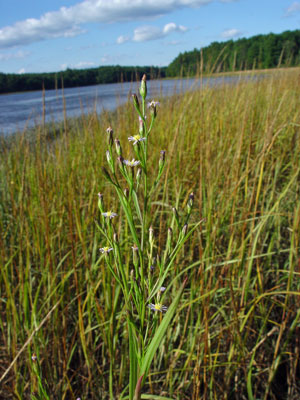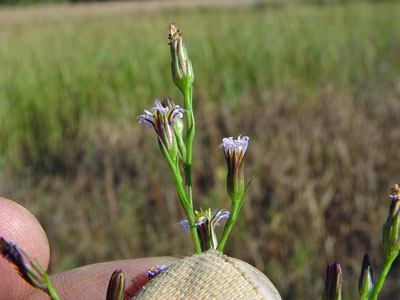DACF Home → Bureaus & Programs → Maine Natural Areas Program → Communities, Plants, and Animals → Rare Plants → Symphyotrichum subulatum

Symphyotrichum subulatum (Michx.) Nesom
Small Salt-marsh Aster
- State Rank: S1
- Global Rank: G5T5
- State Status: Endangered
Habitat: Saline marshes. [Tidal wetland (non-forested, wetland)]
Range: Southern Maine to Florida and Louisiana.
Aids to Identification: The annual salt-marsh aster is distinguished by its habitat (the only other aster typically found in saltmarshes is S. novi-belgii) and its very short ray flowers that barely exceed the disk flowers. The leaves are somewhat fleshy, smooth, entire, and narrowly lance-shaped.

Ecological characteristics: In Maine, this aster is uncommon even within its known stations, occurring most often singly or in small groups. Because it is an annual and grows in small numbers, it may not reappear consistently in exactly the same locations. It usually grows near the high-tide line in brackish estuaries in association with species of Bidens.
Phenology: Flowers late July - October.
Family: Asteraceae
Synonyms: Maine and New England populations represented by var. subulatum. Synonyms include Aster subulatus Michx.; Aster subulatus Michx. var. euroauster Fern. & Grisc.; Aster subulatus Michx. var. obtusifolius Fern.
Known Distribution in Maine: This rare plant has been documented from a total of 5 town(s) in the following county(ies): Sagadahoc, York.
Reason(s) for rarity: Northern limit of its range.
Conservation considerations: Prevent degradation of saltmarsh and estuary habitat from adjacent land uses.